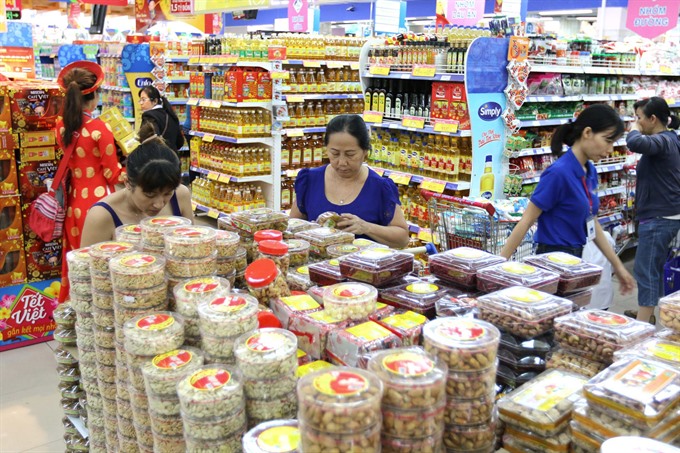 Economy
Economy

Industry and trade departments in Hà Nội and HCM City are planning to spend VNĐ28.5 trillion and VNĐ18.4 billion, respectively, to prepare goods for next year’s Tết festival.
 |
| Industry and trade departments in Hà Nội and HCM City are planning to spend VNĐ28.5 trillion and VNĐ18.4 billion, respectively, to prepare goods for next year’s Tết festival. — VNA Photo |
HÀ NỘI — Industry and trade departments in Hà Nội and HCM City are planning to spend VNĐ28.5 trillion and VNĐ18.4 billion, respectively, to prepare goods for next year’s Tết festival.
Trần Thị Phương Lan, deputy director of the Hà Nội Department of Industry and Trade, said the plan on preparing goods for the New Year and the Lunar New Year in 2019 will focus on increase of essential commodities.
These include rice, meat, seafood, eggs, processed foods, fresh vegetables, dried agro, forestry and seafood products, confectionery, wine, beer beverage and fresh fruit.
The total value of goods under the plan is estimated to increase by 10 per cent compared to the VNĐ28.5 trillion spent this year.
The volume of goods in stock will also increase by 10-15 per cent compared with normal months of the year to meet consumer demand during those occasions and to make sure goods are still available after Tết, Lan said.
This plan on production, business and stockpiling of goods has been built based on the population, business situation of companies, market development and purchasing power in the first nine months of this year in the city, she said.
Hà Nội’s goods will include 190,600 tonnes of rice, 44,000 tonnes of pork, 14,600 tonnes of chicken, 12 tonnes of beef, 256 million eggs, 254 tonnes of vegetables, 3,000 tonnes of confectionery and 200 million litres of beer and beverage.
According to General Director of Trading Hanoi (Hapro) Vũ Thanh Sơn, they plan to keep essential goods in stock and will organise sales points to avoid lack of goods before, during and after the Lunar New Year.
Big supermarkets such as Big C, Fivimart and Vinmart have prepared enough supplies and avoid a lack of goods and overpricing. In addition, large supermarkets have prepared a large volume of fruit and imported food to serve high-end consumer.
Goods in HCMC
The HCM City Department of Industry and Trade has completed a plan with a growth of 23-36 per cent in volume against the same period of 2018, reported the Lao động (Labour) newspaper.
The total value of food and foodstuffs for two months before and during the Tết in 2019 was estimated at VNĐ18.4 trillion, up 3.44 per cent compared to the same period of 2018.
According to the department, to ensure goods reach consumers with the best price, enterprises will increase the sales points in remote areas, industrial parks, export processing zones, residential areas for worker and companies having a large number of workers.
Meanwhile, Hà Nội’s authorities will also create good conditions for businesses to bring stocks to the rural areas, export processing zones and industrial zones, said deputy chairman of Hà Nội People’s Committee Nguyễn Doãn Toản.
The city will promote control of smuggled, fake and poor quality goods as well as food hygiene and safety violations.
According to the Ministry of Industry and Trade, in the last months of the year, demand on raw materials for production of consumer goods and goods for Tết has begun to increase so there is little increase in price as the supply of local and import goods is plentiful.
With these developments, the ministry forecasts the local market this year will basically remain stable and ensure supply meeting local demand. Therefore, total revenue from retail sales and services in 2018 will increase by 10-11 per cent compared to 2017.
In the first 10 months of this year, Việt Nam’s total revenue from retail sales and services grew as consumers paid more, reaching VNĐ3.6 quadrillion (US$154.51 billion), a year-on-year increase of 11.4 per cent, according to the GSO.
The increase accounting for inflation was 9.31 per cent, higher than the 8.79 per cent growth seen in the first 10 months of 2017. — VNS